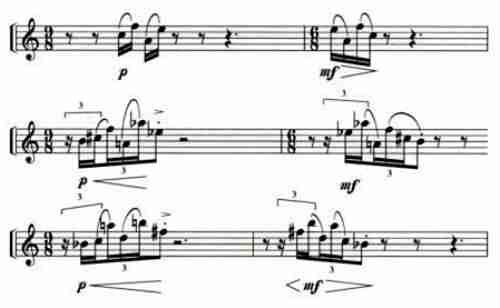
[50-sec clip, Toru Takemitsu, ‘vers, l’arc-en-ciel, palma’, John Williams, Gareth Hulse & London Sinfonietta, 2.2MB MP3]
Slightly larger than the oboe, the oboe d’amour has a darker, less assertive tone—an alto timbre and personality. It’s a transposing instrument, and it sounds a minor third lower than it’s written (i.e., C is A). The oboe d’amour uses a ‘bocal’ and has this pear-shaped bell, similar to the larger English Horn.
Among contemporary works for this instrument I especially like Toru Takemitsu’s ‘Vers, l’Arc-en-Ciel, Palma’ (Verse, Rainbow, Palma/Caliper) for guitar and oboe d’amore soloists with orchestra. It’s nominally Takemitsu’s homage to the painter Joan Miró whom Takemitsu met in 1970—but it’s an interesting piece in a variety of other ways as well.
To me, it urgently begs the question of what the boundaries of chamber music are. This symphonic piece encloses or encapsulates a duet between the oboe d’amour and guitar. Here we have chamber music sounds within orchestral playing. Hulse and Williams interact beautifully, authentically.
[50-sec clip, Toru Takemitsu, ‘vers, l’arc-en-ciel, palma’, John Williams, Gareth Hulse & London Sinfonietta, 2.2MB MP3]

The piece is an essay on music’s cohesive social power, capable of guarding the lovers from the outside world and facilitating their growth as individuals and as a couple. The symphonic sound masses form the walls that define the intimate space that the couple occupies. Transparent textures and clear lines make the intimacy even more striking.

Maybe this music is too tepid for Valentine’s Day? The protagonists each in turn adopt an ironic stance, distancing themselves from their shared experience. The musical dialectic prompts us to likewise take a step back to contemplate the borders and limits of emotional experience and communication. Both the writing and the performance show great sensitivity to colors and drama. On second thought, the authenticity of the ‘Thou-ness’ that’s displayed here between the guitar and the oboe d’amour makes this an entirely appropriate piece for Valentine’s. The Takemitsu composition and these two performers clearly believe in a transcendental Self – and have a sense of the interiority and trueness to self that that transcendent belief implies – and the challenge and moral duty that it poses. And authentic subjectivity is always romantic. Valentine’s it is, then.
Another wonderful oboe d’amour player is Jennifer Paull—who performs oboe d’amour works by de Caix d’Hervelois, Marais, Bach, Telemann, Stölzel, Schurmann, Graupner, Böhm, Heinichen, Lotti, Fasch, Quantz, Kuhnau, Forster, Graun, Janitch, Chelleri, and Prowo. Her ‘Volume 2’ CD has oboe d’amour works by William Blezard, Edwin Carr, Wilfred Josephs, John McCabe, John Rushby-Smith, Leonard Salzedo, and Harold Schiffman. Some links below, for your interest.
B ach’s favourite tonalities for hautboy d’amour were A minor and D minor (23 solos in each). When he began composing a piece and had to decide the tonality to put it in, surely one of the important considerations was how it would sound on the obbligato instrument ... Bach usually kept the fingered key, even when he switched sizes of the hautboy.”
— Bruce Haynes, p. 217.

- Gareth Hulse page at RCM London
- Hulse G, Williams J, London Sinfonietta. Takemitsu: Vers, L’Arc-en-Ciel, Palma. (Sony, 1991.)
- Gareth Hulse at Nash Ensemble
- Oboe d’Amour page at Howarth.co.uk
- Jennifer Paull page at Amoris Consort
- Paull J, Canuti S, Sartoretti C. Caix d'Hervelois: Les Vendangeuses & La Gracieuse / Marais: Les Folies d'Espagne. (Doron, 1996.)
- Paull J. Oboe d'Amore Collection, Vol. 1. (Amoris, 1997.)
- Paull J. Oboe d'Amore Collection, Vol. 2. (Amoris, 1997.)
- Burt P. The Music of Toru Takemitsu. Cambridge Univ, 2006.
- Haynes B. The Eloquent Oboe: A History of the Hautboy from 1640-1760. Oxford Univ, 2001.
- Takemitsu T. Confronting Silence: Selected Writings. Fallen Leaf, 1995.
- Wade B. Music in Japan: Experiencing Music, Expressing Culture. Oxford Univ, 2004.
- Takemitsu page at Karadar Classical
- Takemitsu T. "Vers, l'Arc-en-Ciel, Palma" Score. Schott / Hal Leonard, 1992.
- OboeClassics.co.uk
- Oboe duets at Midwest Musical Imports
No comments:
Post a Comment